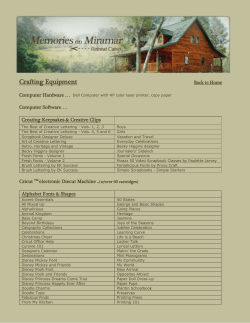
How to Apply Your Custom Vinyl Graphics
How to Apply Your Custom Vinyl Graphics NOTE: We are not responsible for materials damaged during applications not performed by FASTSIGNS. PLEASE: Read all the instructions carefully. Make sure you NEVER get the waxy backing paper wet! Only the transfer tape and vinyl decal may get wet. Wet backing paper will ruin your decals. 1. Temperature Requirements 120 110 100 90 80 70 60 50 40 30 Surface temperature should be between 50 and 90 degrees Fahrenheit before attempting the installation. As a general rule, if the surface is hot to the touch, it’s over 90 degrees Fahrenheit. Adhesive becomes brittle when it gets too cold and gummy when it gets too hot. Applications outside the recommended range of 50 to 90 degrees Fahrenheit reduce the adhesives’ ability to perform. 20 10 2. Surface Preparation Freashly painted surfaces must be dried a minimum of 30 days prior to application of decals, depending on the paint (give us a call if you must apply sooner than 30 days). All surfaces are contaminated to some degree. To ensure good adhesion to any surface, it is critical that you follow these recommended procedures. ~ Wash and rinse the area with liquid dish detergent and warm water. Then dry surface with a clean, lint-free towel or cloth. ~ Finish up the cleaning process by wiping down the entire area with Isopropyl Aclcohol (rubbing alcohol). If the surface is painted, test the alcohol in an inconspincuous area first. ~ To avoid recontamination during the final cleaning step, wipe the surface in just one direction, using a clean, lint-free towel or cloth. You are now ready to apply the vinyl. 3. Wet or Dry Application Dry: Although quicker, applying vinyl graphics dry does not allow for any mistakes. Once the vinyl touches the surface, there is no removal without damage. (Die-cut letters under one inch tall and thin graphics are too risky to wet apply and should be applied dry.) If you decide to use the dry methon, skip the steps on the following page that call for the soapy water solution. Wet: Apply vinyl graphics with application spray allows you the opportunity to remove and reposition vinyl as needed for up to several minutes. It takes a little more time, but there’s less chance of ruining the decal. 4. Application Procedures A. Use a water-soluble pencil to draw guide-lines and center lines of the lettering. Find the center of the lettering. and make a mark at the point on the transfer tape. E. Place the lettering and transfer tape onto the surface, using any guidelines you have made to help align the decal. Do not excessively stretch the vinyl during application; pull it only as taught as necessary. B. For wet application, fill a spray bottle with a mixture of water and 3 drops of liquid dish detergent. F. Squeegee the lettering by starting in the center and using a stright up and down motion, working your way to each left and right edge. You should overlap your strokes to prevent air and water from getting trapped under the lettering. C. Before applying, rest the lettering face down on a flat surface and squeegee across the backing paper. (This helps make the vinyl adhere to the tape rather than the backing paper). Then, with the lettering still face down, peel the backing paper away from the vinyl lettering, which will remain adheared to the transfer tape. G. WAIT ONE HOUR If applied wet, leave the application tape attached to the lettering and let it dry about an hour. D. Lightspray the exposed sticky side of the lettering with the soapy water solution. (If the letters are smaller than the one inch in height, do not use the spray; it could cause misalignment. Very small letters should be applied dry). © 2012 FASTSIGNS INTERNATIONAL, INC. H. Remove the application tape: Pull slowly, back onto itself at a 180 degree angle. This will minimize the chance of pulling lettering up with the tape. TIP. If the lettering is pulling up with the tape, either heavily soak the application tape with the soapy water solution, or wait an additional 15 minutes and try again. Bubbles should be ponctured with a pin. Do not slit the vinyl to release the air (this could cause a spread or gap).
© Copyright 2025





















